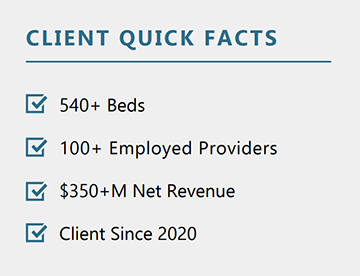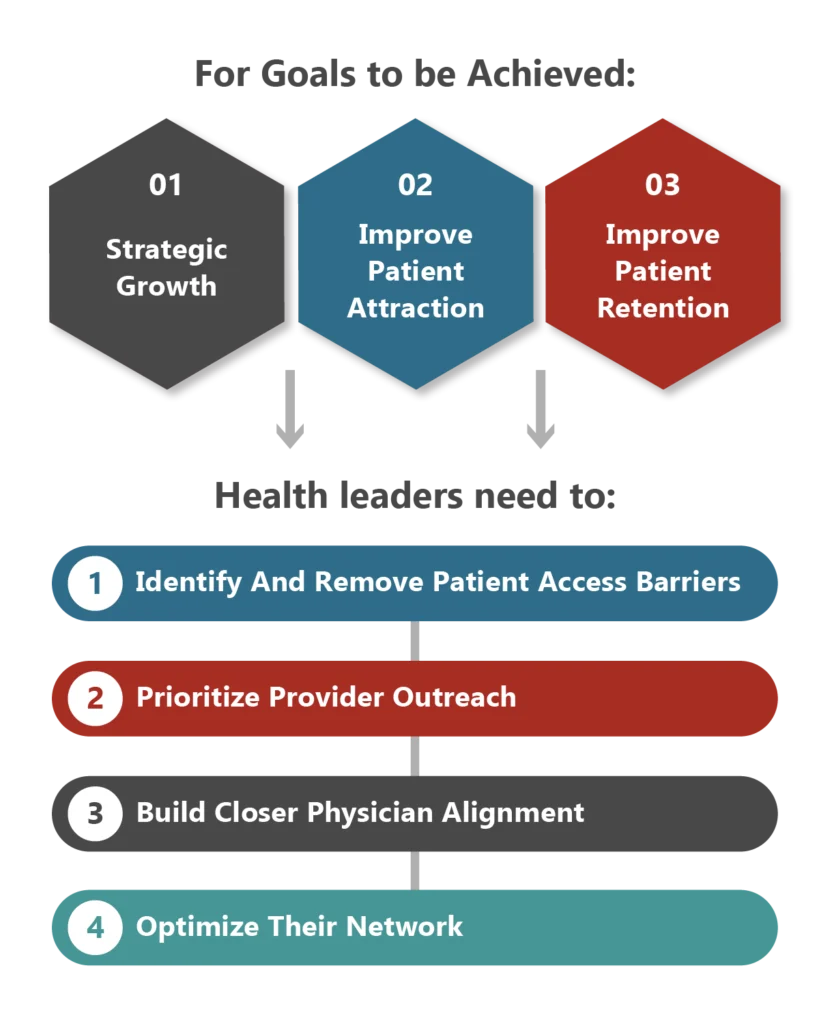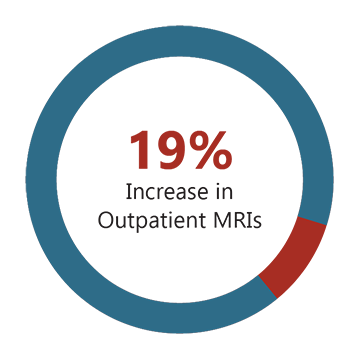Overview:
Georgia-based Archbold Medical Center is a four-hospital, three nursing-home health system with 540 patient beds, a medical staff of nearly 200, and over 2,500 employees. Its mission is to provide safe, innovative, and compassionate care for its patients and residents while working toward its vision of a healthier region, stronger communities, meaningful work, and trusted care.

Challenges:
Archbold Medical Center aimed to achieve strategic growth, improve patient attraction, and improve patient retention. To achieve these interrelated goals, its healthcare leaders needed to identify and remove patient access barriers, prioritize provider outreach, build closer physician alignment, and optimize their network.
Approach: Growth Opportunities for Healthcare
Archbold’s leadership team outlined an
approach that focused on six core areas.
- Access: Improve scheduling and referral processes to remove access barriers for new patients and streamline their onboarding
- Physician Engagement: Enhance leadership and physician alignment, develop targeted recruitment strategies, and create systems to improve network retention
- Internal Teamwork and Collaboration: Improve communication across key departments, service lines, and practices
- Community Awareness: Strengthen awareness of Archbold’s key services across its community geographies and implement new outreach mechanisms for issue resolution
- Data: Integrate data analytics as part of leaders’ decision-making processes; utilizing timely and relevant internal and external data to be nimbler and more accurate in management decisions
- Outreach and Marketing Tools: Develop updated outreach tools, referral programs and protocols, and establish greater recognition of employed medical group

Solutions:
Archbold Medical Center identified opportunities for $122 million in revenue growth. They achieved rapid results and sustainable growth by engaging stakeholders in a collaborative process, identifying and solving access and capacity barriers, prioritizing service line strategy development, and executing a nationally recognized professional physician outreach program.

Implementation:
Specifically, Archbold implemented its solutions by partnering with Tiller-Hewitt Healthcare Strategies and HSG Advisors to tackle identified opportunities. Archbold utilized a few key data elements throughout the process, including:
- Provider Relationship Management (PRM) system (TrackerPLUS) to increase efficiency and accountability, streamline processes, and identify, escalate, and resolve issues that create access bottlenecks and growth barriers
- Internal practice referral data along with external third-party claims data (HSG Claims Data Analytics) to identify patient leakage opportunities
Leveraging these data elements, Archbold was able to:
- Understand current alignment with independent primary care providers within the marketplace and determine how loyalty varies by geography, practice, and specialist service offering
- Evaluate if there were specific specialties and/or services that the health system was drawing from competitors to attract incremental patients to the system
- Utilize data to support the recruitment of new physicians and to determine practice ramp-up speed and expected patient volumes
Key Takeaways
Archbold noted three important takeaways from the process that they will integrate into all future strategic plans:
- Engage Stakeholders in Growth Discussions—including executive leadership, service line leadership, and all levels of providers
- Leverage Data (Internal and External) along with qualitative feedback from stakeholders. The combination of quantitative data and qualitative feedback enhances decision-making and increases stakeholder engagement.
- Build a Process for Measuring the success of growth objectives and establish protocols for ongoing management.
Results:
With these solutions in place, Archbold recorded $122 million in incremental top-line revenue, $34 million in incremental net revenue, a 22% increase in outpatient CTs, and a 19% increase in outpatient within the first year of implementation.




Conclusion:
Archbold Medical Center successfully grew its patient volume by utilizing data to identify opportunities for growth, engaging stakeholders, and implementing a structured approach to reaching its growth and revenue targets. It better positioned its healthcare leaders to make efficient, informed, and strategic decisions which led to attracting new patients and an increase in retention. Archbold established new protocols and standard operating procedures that continue to provide benefits long after the consulting engagement ended, including service line prioritization, collaborative communication between cross-functional teams, and agreed-upon metrics for success. Ultimately, Archbold Medical Center was able to achieve significant growth while upholding its high standards of compassionate patient care.